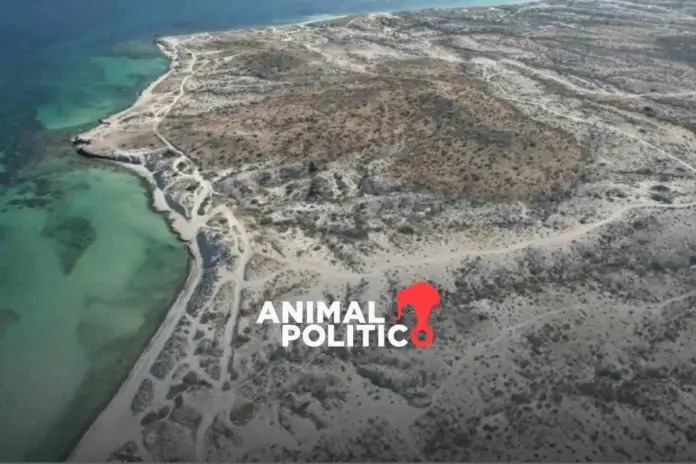
Kuni is a mega real estate investment project with tourism components, promoted by the company Maravia, which expands like a 9-kilometer barrier and can prevent or control access to more than 18 kilometers of beaches in the city of La Paz, Baja California Sur, northwest of Mexico.
The mega project has a surface area of 1,658 hectares where it intends to build 20,000 hotel rooms and more than 3,000 homes, on an area that extends from El Tecolote beach to Puerto Mexía, where there are only two access roads that lead to eight beaches that the population of La Paz regularly visits: Las Pilitas, El Pulguero, Punta Galeras, Punta Arranca Cabello, Cachimba, Punta Coyote, Piedras Blancas and Puerto Mexía.
“The implementation of a project like this could generate limitations in access to beaches, causing social conflicts by violating the rights to enjoy public and recreational spaces for the inhabitants of La Paz. In addition, this model of tourist-residential project could modify the local socioeconomic structure, increasing the prices of goods and services, causing the displacement of communities by converting areas of the territory into exclusive areas,” said the alliance of organizations formed by BCSicletos, the Mexican Center for Environmental Law (Cemda), the Center for Renewable Energies and Environmental Quality, Cómo Vamos La Paz and the Center for Biological Diversity in a statement.
The Environmental Impact Statement (EIS) presented by the company mentions that the project has access to Zofemat that is used by the general population. However, it does not commit to complying with the requirements established for all developments bordering the beach and Zofemat in the Urban Development Program of La Paz, to consider wide accesses (between 8 and 13 meters wide) to Zofemat with a distance of at least one kilometer between each one in coordination with the City Council of La Paz and the Secretariat of Environment and Natural Resources (Semarnat) to maintain and improve access to the beaches.
To avoid the privatization of public and historic access roads to these beaches, the platform Es Mi Playa, Mi Barrio, requires the City Council of La Paz to register the roads in question as public roads with the General Directorate of Cadastre. As well as the establishment of coastal buffer zones that regulate the type of works adjacent to Zofemat.
This is because the State has the obligation to impose on private property the modalities dictated by the public interest, for the benefit of the common good according to article 27 of the Mexican Constitution.
“The nation shall have the right at all times to impose private property in the manner dictated by the public interest, as well as to regulate, for the benefit of society, the use of natural elements susceptible to appropriation, in order to make an equitable distribution of public wealth, take care of its conservation, achieve the balanced development of the country and the improvement of the living conditions of the rural and urban population,” the article states.
On August 15, Semarnat announced the opening of the public consultation of the megaproject, which entered the Environmental Impact Assessment Procedure (PEIA).
From that moment, hundreds of people began to organize around a movement called Urgent Action La Paz, which called for a massive public meeting and later a demonstration attended by more than 500 people to show their dissatisfaction with the project, mainly against the appropriation of beaches and the destruction of coastal landscapes, among many other environmental impacts.
“All along the coast, these types of real estate projects are planned with tourist components, whose central space, the attraction, the central resource is the beach, the access to the sea. Without the beach, they wouldn’t be here. Given all this growth plan that already exists, what we have left is to defend public goods and resources for common use such as water, beaches, traditional paths, access to all of that,” said Carmina Valiente, research professor at the Autonomous University of Baja California Sur.
“This is a massive tourism project to be carried out in the vicinity of the Balandra protected natural area and the most popular beaches where families and visitors to La Paz go. What will the project bring to La Paz? Huge population growth, very low-income jobs, large amounts of garbage and greenhouse gas emissions, destruction of the landscape that attracts tourists who visit us, deterioration of the marine and coastal environment that provides us with food and recreation and is also the main attraction for tourists who come to La Paz, and impact on access to the beaches enjoyed by permanent and temporary residents,” said Micheline Cariño, professor-researcher at the Autonomous University of Baja California Sur, during the demonstration.
For this report, we tried to contact the Maravia company through the communication channels it offers publicly but it was not possible to establish communication.
In order to participate in the public consultation, Cemda made available a form to present technical opinions regarding the project, which must be delivered in physical form to the offices of the Semarnat delegation in Baja California Sur, located at Melchor Ocampo 1045, Centro neighborhood, in the city of La Paz, before September 23.
Anticipating the impacts that this project may cause in environmental, social and cultural matters, citizens and organizations request the holding of a public information meeting.
In addition, considering the impossibility of attending in person, a petition has also been enabled on the Change.Org portal where people can sign electronically to show their disagreement.
Source: es-us.noticias.yahoo






